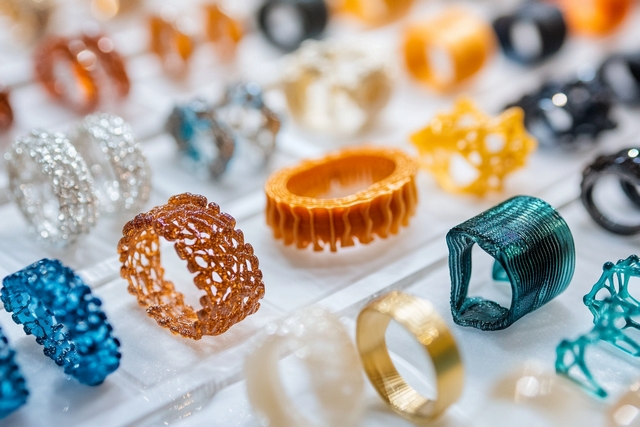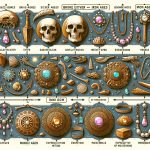The evolution of 3D printed jewelry: past, present, and future is a fascinating journey highlighting the extraordinary fusion of artistry and technology. As creativity meets innovation, boundaries in traditional craftsmanship are being redefined by digital advancements. With its transformative potential, 3D printing is revolutionizing how we conceive, design, and manufacture jewelry today. This captivating interplay not only paves new paths for creativity but also ushers the jewelry industry into an era where imagination knows no bounds.
At its core, 3D printing technology involves creating tangible objects from digital designs by layering material. Initially used in industries like aerospace and healthcare for prototyping purposes, this groundbreaking technology has found its way into the intricate world of jewelry making.
The impact on design and production processes has been profound; designers now have the freedom to explore complex geometries that were once considered impractical or impossible with conventional methods. Furthermore, this technological shift speeds up production timelines while offering unparalleled customization options tailored to individual tastes.
As we delve deeper into this realm, it’s crucial to understand how this integration began reshaping the industry landscape. Pioneering designers and forward-thinking companies observed early on that marrying 3D printing with traditional jewel crafting could unlock new possibilities.
By creating unique patterns and structures while minimizing waste materials-which appeals to both financial prudence and environmental sustainability-this innovative approach effected major changes across global markets. It set a precedent for what was possible when technology met tradition in one of humanity’s oldest art forms.
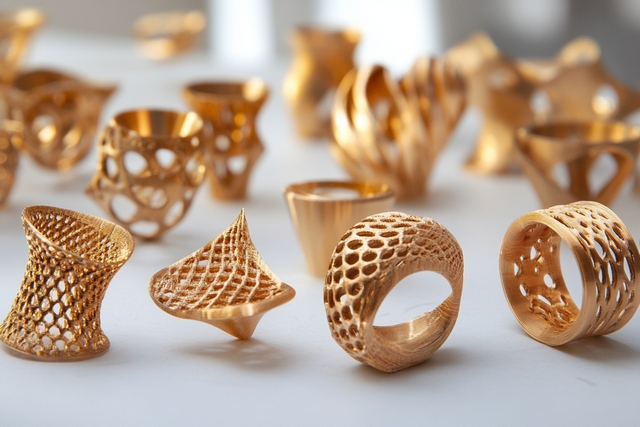
The Origins of 3D Printed Jewelry
The Dawn of 3D Printing Technology
In the early stages, the concept of 3D printing was nothing short of revolutionary. Although its primary application aimed at industrial purposes, its potential in other fields soon became apparent. The initial idea was to harness digital designs and transform them into tangible objects through an additive process, building up layers one at a time.
This approach began gaining traction in the 1980s as companies like 3D Systems developed stereolithography (SLA) technology. It wasn’t long before forward-thinking designers recognized the transformative possibilities this technology held for jewelry creation.
Pioneer Designers and Innovators
The evolution of 3d printed jewelry: past, present, and future can be charted back to visionary artists and technologists who dared to think differently. Among these pioneers was American artist Bathsheba Grossman, whose work with mathematical structures inspired many in the early stages of digital fabrication for art forms including jewelry.
Her intricate geometric pieces shed light on how complex patterns could be realized with precision-a feat not easily achieved through traditional methods. Another trailblazer was Francis Bitonti, a designer who became renowned for integrating computational design techniques within fashion and accessory lines, pushing boundaries beyond conventional craftsmanship.
Early Adoption by Forward-Thinking Companies
Beyond individual pioneers, certain companies were instrumental in laying down the foundation for today’s thriving market in 3D printed jewelry. In particular, Materialise emerged as an influential entity by collaborating with jewelry designers to apply their substantial expertise in open-source software and proprietary printing technologies across different creative industries.
Meanwhile, Shapeways offered platforms where designers could experiment with novel ideas unconstrained by production limitations typical within traditional molds or casting techniques. These collaborations cultivated an ecosystem where creativity flourished-setting vital precedents that heralded this innovative medium’s journey from obscurity toward mainstream acceptance within the larger jewelry industry landscape.
Technological Advancements
The Rapid Evolution of Technology
As we consider the evolution of 3D printed jewelry: past, present, and future, it’s essential to acknowledge how advances in technology have significantly shaped the current landscape. Over the years, 3D printing technology has transitioned from a nascent experimental phase to a sophisticated tool embraced by jewelers globally.
With enhanced precision and versatility, today’s printers can create complex geometries and intricate designs that were previously impossible or impractical using traditional fabrication methods. Techniques such as Selective Laser Sintering (SLS) and Stereolithography (SLA) have evolved significantly, allowing for higher resolution prints with superior surface finish and detail.
Innovative Materials Transforming Creations
The advancement of materials used in 3D printed jewelry has also been transformative. Initially dominated by basic polymers and resins, today’s offerings include an impressive array of specialized metals such as gold, silver, titanium, and platinum alloys. These materials mimic traditional gemstones’ resilience and appearance while offering innovative design capabilities.
The ability to incorporate a variety of finishes and colors further expands the creative horizons for designers who use this technology. Consequently, jewelers are now equipped to experiment with form and function like never before, producing pieces that challenge conventional aesthetics.
Key Milestones in Adoption
In understanding the evolution of this revolutionary technology within the jewelry industry, it is useful to highlight significant milestones that underscore its adoption. The introduction of cost-effective desktop printers made 3D printing accessible not only to large manufacturers but small artisan jewelers alike.
By 2019, reports indicated that over one-third of jewelry makers had adopted some form of 3D modeling or manufacturing in their processes-a figure expected to rise continuously. Furthermore, collaborations between tech companies and fashion houses showcase the disruptive power of these advancements through exclusive collections unveiled at high-profile events like Paris Fashion Week, underscoring market breadth acceptance across different sectors influenced by fashionable trends.
Current Trends in 3D Printed Jewelry Design
In recent years, the evolution of 3D printed jewelry: past, present, and future has taken on a transformative role in the design landscape. Currently, the trend is gravitating towards minimalistic yet complex geometries that appear deceptively simple at first glance but reveal intricate detailing upon closer inspection.
This type of design ethos leverages the precision and agility of 3D printing technology to produce pieces that are otherwise impossible or costly to craft using traditional methods. One standout example is generative design-a technique that uses algorithmic software to create organic and fluid forms, offering designers an endless palette to redefine aesthetic boundaries.
Beyond form, material innovation also plays a significant role in these current trends. Traditional materials like gold and silver are increasingly being complemented by modern alternatives such as biodegradable plastics and high-tech resins which cater to a rising consumer awareness regarding sustainability. These new materials not only expand creative possibilities but also address practical concerns like cost reduction and environmental impact.
For instance, titanium-based materials have gained traction for their lightweight properties and hypoallergenic benefits. Such material advancements reflect broader industry goals where functionality meets artistic aspiration without sacrificing sustainability.
Moreover, customization has become a centerpiece of consumer demand within the realm of 3D-printed jewelry. Today’s consumers seek unique experiences tailored to their personal tastes and 3D printing offers precisely this kind of bespoke service at a scale previously unimaginable.
With scanning technologies making it possible to personalize designs with incredible detail, from engravings to specific dimensions suited for individual preferences, custom-order platforms have surfaced as major players in this market space. This surge towards personalization underscores shifting paradigms in consumer behavior-from passive acceptance of mainstream offerings to active participation in bespoke creation-which could redefine how brands approach product development moving forward.
| Current Trend | Examples/Details |
|---|---|
| Generative Design | Uses algorithmic software for complex geometries. |
| Sustainable Materials | Biodegradable plastics and high-tech resins. |
| Customization | Personalized designs via scanning technologies. |
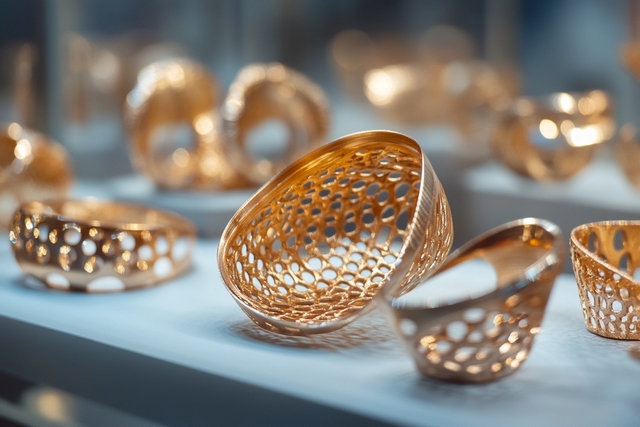
Benefits of 3D Printing in Jewelry Manufacturing
The advent of 3D printing has revolutionized the jewelry manufacturing process, offering a plethora of benefits that have transformed the industry. One of the most significant advantages is the dramatic reduction in production costs. Traditional jewelry-making methods often involve expensive labor and materials, not to mention the waste generated during crafting processes such as carving or lost wax casting.
In contrast, 3D printing streamlines production by fabricating precise designs with minimal material wastage. This cost-effectiveness extends beyond materials; it also influences labor costs by reducing the number of skilled artisans required for complex pieces, allowing manufacturers to produce high-quality designs at a fraction of traditional costs.
Time efficiency is another critical benefit offered by 3D printing technology in jewelry manufacturing. By leveraging advanced software and hardware capabilities, designers can take complex concepts from digital renderings to physical prototypes much faster than ever before.
This rapid prototyping ability accelerates product development cycles significantly, facilitating quicker market entry for new collections and enabling designers to iterate on products swiftly based on consumer feedback or market trends. Such agility is invaluable in an industry where timely responsiveness can dictate success amidst rapidly shifting consumer desires.
Personalization and sustainability are also key aspects facilitated by this revolutionary technology. Today’s consumers often seek unique pieces that reflect their personal styles and preferences-an emerging demand beautifully addressed through 3D printing’s inherent customization capabilities.
The evolution of 3D printed jewelry: past, present, and future highlights how personalization empowers both designers and customers alike to innovate freely without traditional constraints like molds or fixed designs. Additionally, this technology supports sustainability efforts within the industry by significantly reducing waste materials usage and promoting recycling initiatives for leftover powder or filament from non-successful prints.
| Benefit | Description |
|---|---|
| Cost Efficiency | Reduces material waste and labor costs. |
| Time Efficiency | Speeds up product development cycles through rapid prototyping. |
| Customization | Allows personalized designs without traditional constraints. |
Challenges and Limitations
The landscape of 3D printed jewelry, while innovative and promising, is not without its challenges and limitations. A primary issue arises from the design constraints inherent in current 3D printing technologies. The intricate detail that traditional jewelers can achieve through handcrafting isn’t always replicable with 3D printing.
Even as printers have evolved to produce finer resolutions, the level of craftsmanship required for high-end jewelry often surpasses what machines can currently achieve. This limitation forces designers to sometimes compromise on complexity or seek hybrid methods that combine both traditional and digital techniques, marking a pivotal point in the evolution of 3D printed jewelry: past, present, and future.
In addition to design limitations, material constraints present significant hurdles. While materials such as polymers and certain metals are frequently used in 3D printing processes, they don’t always match the quality or durability expected by discerning customers accustomed to conventional precious metals like gold or platinum.
The development of new materials specifically engineered for 3D printing has made strides but remains an area requiring further innovation. These material challenges also affect the long-term sustainability of wearables created using this technology, as some consumers are concerned about the environmental impact associated with synthetic substances compared to more traditional options.
Moreover, the burgeoning field faces issues related to intellectual property (IP) rights and market acceptance. With digital designs easily shared across platforms, protecting original creations becomes more complex than in standard jewelry markets where physical prototypes are guarded until a piece is ready for production.
Designers must navigate these legal territories delicately to ensure their innovations aren’t pirated, which could stifle creativity and innovation in fear of IP theft. Market acceptance also plays a crucial role; while tech-savvy consumers might embrace these new-age pieces readily, others who value historical craftsmanship may be hesitant to adopt what they perceive as less authentic alternatives.
Despite these obstacles, stakeholders within the industry continue working tirelessly toward overcoming these barriers through continuous research and development efforts. Collaborative initiatives between technologists and artisans aim to meld traditional jewelry-making techniques with state-of-the-art digital manufacturing processes-a testament to how integral human ingenuity remains amidst technological advances in reshaping the theme central to discussions on the evolution of 3d printed jewelry: past, present, and future.
Future Prospects
As we gaze into the future of 3D printed jewelry, there is an exciting horizon filled with potential technological advancements and breakthroughs. The evolution of 3d printed jewelry: past, present, and future indicates that this trajectory will continue upward, driven by the integration of more sophisticated technologies such as artificial intelligence and advanced robotics.
These innovations could lead to unprecedented levels of precision and intricacy in designs, enabling jewelers to craft pieces that are not only aesthetically compelling but also structurally complex. The incorporation of new materials like bioengineered gem-quality stones or sustainable composites will further enhance design possibilities while addressing environmental concerns.
Moreover, the consumer behavior landscape is poised for a significant shift as personalization increasingly takes center stage. Users may soon have access to online platforms where they can co-design their pieces in real time with the help of intuitive design software powered by AI algorithms.
This process will allow customers to experiment with shapes, colors, and textures before committing to a purchase. As such technology becomes mainstream, it adds another layer to how we perceive ownership and uniqueness in jewelry pieces.
The market demand is expected to tilt increasingly towards bespoke creations rather than mass-market products. A few upcoming trends are likely to gain traction:
- Hyper-Personalization: Beyond customizing designs based on preferences, consumers might expect jewelry tailored specifically around personal narratives or sentimental value.
- Smart Jewelry Integrations: Enabling functionalities like biometrics tracking or NFC payment systems in elegant rings or bracelets.
- Augmented Reality Experiences: Through AR applications allowing customers to virtually “try on” different styles before making a buying decision.
In envisioning the vast impact on both mass-market and bespoke offerings, it’s clear that traditional supply chains might experience a transformation as well. Jewelers who embrace this digital revolution early are set to capture competitive advantages by expanding their capabilities while delivering extraordinary customer experiences through these game-changing futuristic tools.
Conclusion
The journey of innovation in the world of 3D printed jewelry is a fascinating tapestry woven with threads of creativity and technological prowess. As we’ve navigated through the historical developments, current trends, and peeked into future possibilities, it’s evident that the evolution of 3d printed jewelry: past, present, and future is marked by an unyielding drive toward perfection.
Artists and engineers alike are constantly pushing the boundaries to achieve not just aesthetic beauty but also functional brilliance in every piece they create.
In reflecting on the evolution of this craft, we acknowledge pivotal milestones that have significantly reshaped the industry. From initial prototypes brought to life through rudimentary techniques to today’s intricately designed masterpieces created with advanced 3D printing technologies, each era has contributed vital advancements.
Designers have embraced materials ranging from resins and plastics to metals and gemstones, each bringing its own set of challenges and rewards. The collaboration between artisan intuition and computerized precision has birthed an entirely new genre of jewelry design that’s both profoundly traditional yet utterly modern.
Looking forward, the landscape continues to evolve at a breathtaking pace as researchers explore novel materials like biodegradable compounds and even conductive elements that promise interactive and sustainable jewelry solutions. This continuing journey not only reflects changes in technology but also mirrors shifts in societal values towards customization, sustainability, inclusivity, and innovation. The potential for further exploration seems limitless; it beckons both seasoned designers and aspiring newcomers to break new ground within this captivating intersection where technology meets artistry.
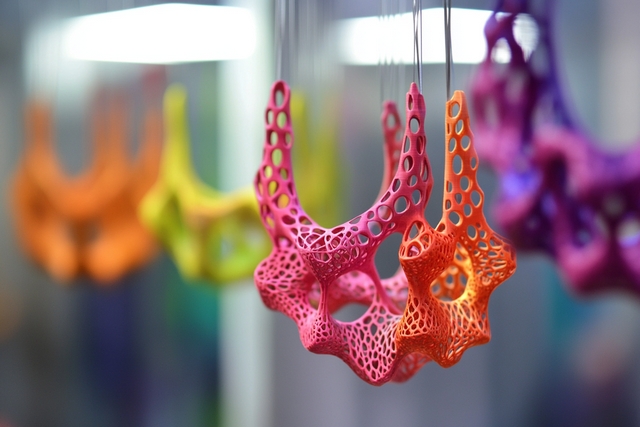
Call to Action
As we close this comprehensive exploration into the evolution of 3D printed jewelry: past, present, and future, it’s clear that this innovative fusion of technology and artistry is shaping a dynamic and ever-expanding landscape. The journey from its early beginnings to its current state demonstrates the remarkable potential and adaptability of 3D printing within the jewelry industry.
From pioneering designers who embraced nascent technologies to today’s trendsetters pushing the boundaries with cutting-edge designs, 3D printed jewelry has consistently evolved in tandem with technological advancements.
This evolution not only transforms how jewelry is conceptualized and manufactured but also challenges traditional notions of design and craftsmanship. As we’ve seen, contemporary techniques leverage advanced materials to produce intricate pieces previously unimaginable without modern technology.
The efficiencies brought by 3D printing in production costs, time savings, customization options, and sustainability underline its value both for mass-market manufacturers and bespoke jewelers alike. However, alongside these benefits lie challenges such as material limitations and intellectual property concerns that continue to shape ongoing developments in this field.
As we peer into the future, the horizon brims with possibilities yet to be realized in the world of 3D printed jewelry. New technological breakthroughs hold promise for even greater customization capabilities and innovation in materials science. Consumer behaviors are expected to evolve alongside these developments, potentially leading to shifts in market demand where personalization meets evolving tastes.
Envisioning this future means recognizing the profound impact on both large-scale production lines and the niche markets served by bespoke collections. The journey of innovation is far from over; it beckons enthusiasts-whether creators or admirers-to engage with this exhilarating evolution that continually redefines what is possible in jewelry design.
We invite you to delve deeper into this fascinating realm through further exploration-connecting with makers, examining new trends, or sparking your creativity by partaking in discussions within this vibrant community dedicated to pushing artistic boundaries through technology.
Frequently Asked Questions
How Has 3D Printing Changed Over the Years?
Over the years, 3D printing has evolved significantly from being a niche technology to becoming more mainstream and accessible across various industries. Originally developed for prototyping purposes in the 1980s, advancements in materials and techniques have enabled it to be used for producing finished goods like aerospace components, medical implants, and consumer products. The technology has not only become more affordable but also faster and more precise.
Improved software capabilities have allowed for complex designs that were previously impossible with traditional manufacturing methods. Additionally, new processes like metal 3D printing have opened up even more possibilities.
What Is the Process of 3D Printing Jewelry?
The process of 3D printing jewelry begins with designing a digital model using computer-aided design (CAD) software, allowing intricate designs with high precision. Once the design is finalized, it is converted into a format suitable for 3D printers, such as STL files. The next step involves selecting the appropriate material, which can range from polymers for prototypes to precious metals like gold or platinum for final pieces.
The printer then creates the item layer by layer based on the digital design. Post-processing steps like polishing or setting gemstones are often required to achieve the desired finish and aesthetic quality in the final piece.

Welcome to my jewelry blog! My name is Sarah and I am the owner of this blog.
I love making jewelry and sharing my creations with others.
So whether you’re someone who loves wearing jewelry yourself or simply enjoys learning about it, be sure to check out my blog for insightful posts on everything related to this exciting topic!

